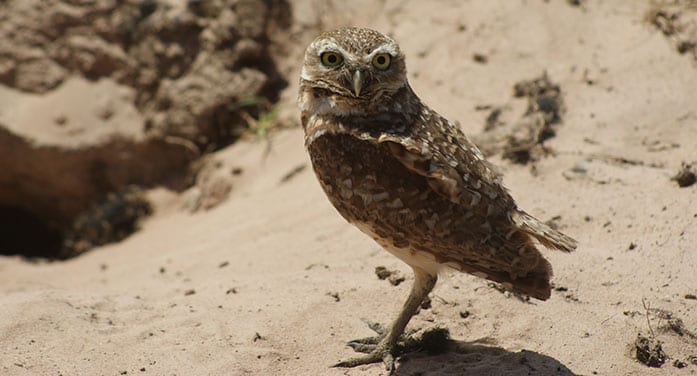 Folklore abounds with superstition related to owls. I thought it might be fun to share some superstitions I’ve gleaned about owls, since this is the best time of year to see them.
Folklore abounds with superstition related to owls. I thought it might be fun to share some superstitions I’ve gleaned about owls, since this is the best time of year to see them.
These nocturnal creatures often appear in horror films since tufts of feathers on the top of some owls’ heads give them the appearance of horned devils and their piercing cries add to the eerie effect they have on us.
What owl can be found worldwide and is known variously as ghost, death or hobgoblin owl? (See end of column for answer.)
Let’s get started.
It’s believed that owls are the only creatures that can live with ghosts, so if an owl is found nesting in an abandoned house, the place must be haunted.
Owls are known to have extraordinary eyesight. It was believed that people could gain better vision by making a potion from the ash from over-cooked owl eggs (Great Britain) or it was easier to just eat owl eyes (India).

To many, the owl was sacred. Among Australian Aborigines, owls were considered the spirits of women and so were protected
In England, folklore also said that if you walked around a tree in which an owl was perched, it would follow you with its eyes around and around until it wrung its own neck.
Owls represent a sign of passing in many cultures, so dreaming of an owl prophesized death for the Apache people. Others feared death if an owl perched on the roof of a house.
In other cultures, owls warned that a traveller would be robbed or a sailor shipwrecked.
Boreal owl calls represented a call from the spirits to the Cree people, and if you answered back to the owl with a whistle and didn’t get a response, it was a sign that your death was imminent.
An owl hooting or screeching at night could result in the death of a newborn baby, could cause the child to have an unhappy life or could mean the baby would become a witch. Greeks and Romans believed witches could turn themselves into owls and in this form would suck the blood of babies.
In some cultures, nailing an owl to the door of a house was considered a way to keep evil at bay. The tradition arose in ancient Rome, after owls were believed to have foretold the deaths of Julius Caesar and several other emperors. The custom persisted in Great Britain up through the 18th century. It was believed that an owl nailed to a barn door protected the livestock within from fire or lightning.
To many, the owl was sacred.
Among Australian Aborigines, owls were considered the spirits of women and so were protected.
Many cultures believed that a person became an owl after death and the Kwakiutl First Nation of British Columbia also thought owls were the souls of people and shouldn’t be harmed. If the owl was killed, the person whose soul the owl carried would also die.
The owl provided guidance to the Inuit of Greenland regarding life decisions.
The people of Indonesia used the owl’s various calls to determine whether to travel.
The Dakota Hidatsa of the United States believed that burrowing owls acted as protective spirits for warriors.
One Afghanistan legend holds that it was the owl that presented humans with flint and iron so they could make fire. In exchange, man gave owls their feathers.
In Brittany, it was a good sign to see an owl on the way to the harvest as it meant that it would be a good yield that year.
The Zuni tribe believed that an owl feather placed in a baby’s crib kept evil spirits away from the infant, while other tribes saw owls as bringers of healing, so a feather could be hung in the doorway of a home to keep illness out.
Clearly some owls were seen as good and others as bad. So as you enjoy this chilly winter weather, watch for owls – but be careful, you never know if they’re good or bad ones!
(The answer to the question above: The death owl is the barn 0wl.)
Geoff Carpentier is a published author, expedition guide and environmental consultant. Visit Geoff online at www.avocetnatureservices.com, on LinkedIn and on Facebook.
The views, opinions and positions expressed by columnists and contributors are the author’s alone. They do not inherently or expressly reflect the views, opinions and/or positions of our publication.


